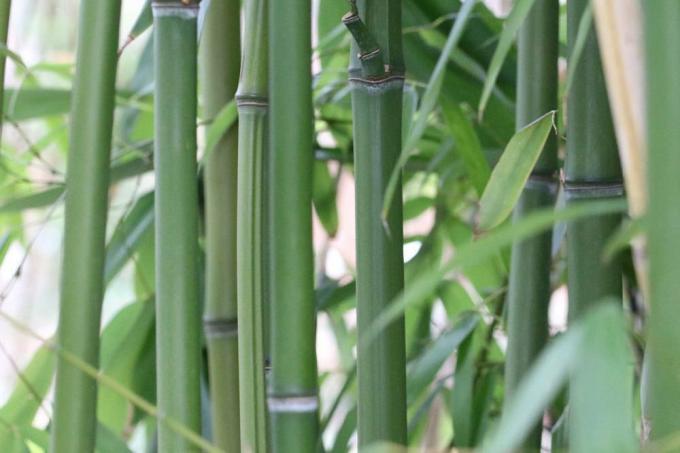
table of contents
- Natural leaf shedding
- Unnatural leaf shedding
- Cold dryness
- Lack of root formation before winter
- Bucket culture
A bamboo hedge is not only a good privacy screen, it also brings something exotic into the home garden. But the plants from the sweet grass family are also found on the balcony or terrace. Poaceaeein, real eye-catchers. The different types of bamboo usually survive the German winter well outdoors. However, it does happen that bamboo dries up despite good winter care. And then the question arises: what to do?
Natural leaf shedding
Although the bamboo is an evergreen plant, it also loses leaves. This natural leaf shedding begins in autumn until late autumn. In doing so, it does not lose all of its leaves, but only discards those that are no longer of any use to it, i.e. leaves that receive too little light for photosynthesis. Regular lighting helps the bamboo, because this way enough light also comes into the interior of the plant.
Unnatural leaf shedding
The following damage patterns are not natural causes, especially in the
winter occur even if you water the bamboo plants regularly:- Shedding of all leaves
- yellow or brown stalks
If these signs appear, then they are an indication that the bamboo roots have suffered damage. This can usually be traced back to two causes:
- Cold dryness
- lack of root formation before winter

Cold dryness
Most of the types of bamboo that are offered for planting in the garden in this country can withstand temperatures down to -25 ° C or -30 ° C. As evergreen plants, however, they also need sufficient water in the cold season, as a lot of moisture evaporates through the leaves. Hence heard regular watering with the sweet grass for winter care, otherwise it dries up.
Cold dryness is understood to mean periods in which there is no precipitation and the thermometer falls far below freezing point. So the weather is dry and cold, which makes the ground freeze. This weather has two consequences for the plants:
- no possibility of water absorption
- Roots dry up
Since the sweetgrass lacks the water it needs to survive, the chances of saving it are poor. Nevertheless, you should give the plants a chance and try to rescue them:
- radically shorten
- pour normally
With a little luck, especially if the root area is not yet completely dry, the plants will begin to sprout again. You should be patient, because the new growth can take up to summer.
tip: If it is cold and dry, water the plants with lukewarm water as a preventive measure, this increases its chances of survival.
Lack of root formation before winter
In order for the bamboo to be able to quench its thirst, it needs sufficient roots. If it does not have enough time to root, the roots can dry out during the winter because they cannot absorb enough water. This often happens when the grass is planted too shortly before winter. Since the consequences are often very serious, the gardener speaks of “complete damage to the bamboo” in this context. This is shown as follows:
- poor growth in spring
- Death of the plant
tip: A planted bamboo only develops its full winter hardiness after three to five years, because it is only after this time that it has really taken root.
What to do? Since bamboo plants are very robust in and of themselves, you should also try to save the grasses in this case. Radically shorten the plants and continue watering them normally. As with cold dryness, the same applies here: with a little luck and patience, they will survive and recover over the year.
Bucket culture
There is also a risk that bamboo plants will dry out during the cold season despite watering if they are kept in a bucket. As with the planted specimens, frozen substrate and the lack of adequate roots are the two biggest enemies in bucket culture.

Overwinter outdoors
If the bamboo is to overwinter outdoors, it must be protected from the penetrating cold. Therefore the bucket is covered with a fleece. Against the cold from below, it is best to place it on a thick wooden board or a styrofoam plate. Make sure that too much water does not fall onto the plant from above, because the grasses cannot tolerate waterlogging in the long term.
Winter inside
So that the cold season cannot damage the bamboo plants, you should look for suitable winter quarters for them. A room with a temperature between three and seven degrees Celsius is ideal. Heated winter quarters are not recommended, as the bamboo cures very quickly there. It is also more susceptible to pests and mold growth. You should also keep the plants rather dry in their winter quarters.
